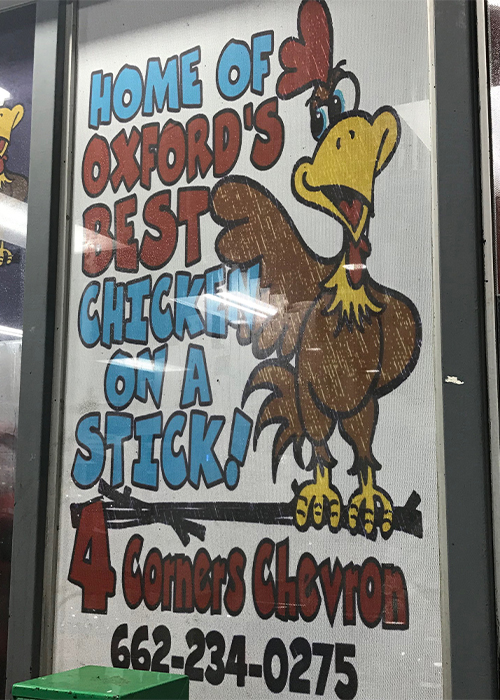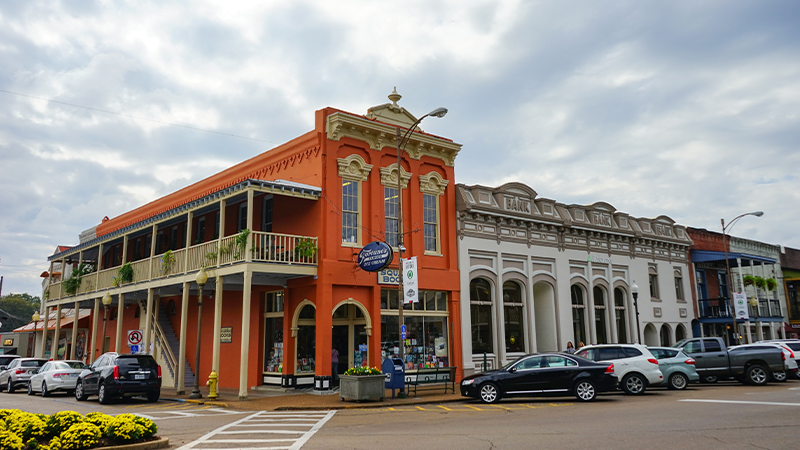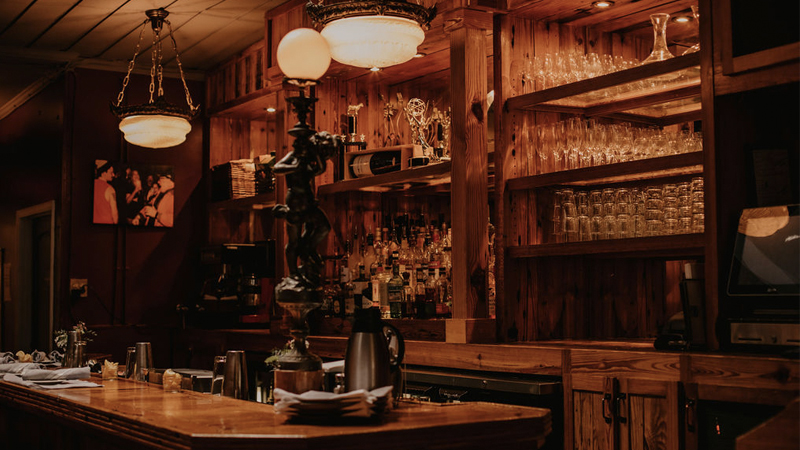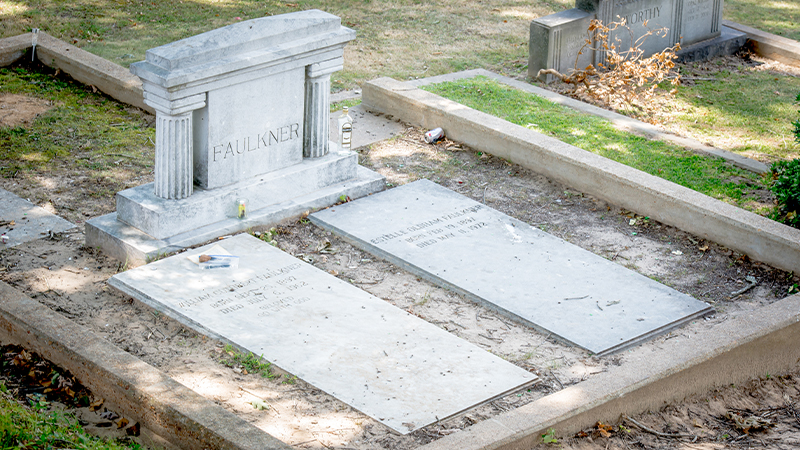The first time I went to Oxford, Miss., was in 2008 when I attended the Southern Foodways Alliance Fall Symposium, an annual gathering of chefs, writers, artists, scholars, bartenders, distillers, and those with a passion for the diverse food cultures of the American South for a weekend of conversations, lectures, and presentations paired with excellent food and drink. That year’s theme was, fittingly, “Southern Drinkways,” and over the next decade I continued to return to Oxford every fall. Each time I wandered the aisles of Square Books, ascended the narrow staircase leading to the upstairs bar at City Grocery, or made one last late-night stop for fried chicken-on-a-stick at the 4 Corners Chevron, I felt like a welcome regular. The nostalgic lure of a college town in autumn is strong and I understand why Oxford is known as the Velvet Ditch, the kind of place that’s “easy to fall into and hard to crawl out of.”
The literary legacy of Oxford also runs deep and many notable writers live, or have lived, there. (William Faulkner’s former home, Rowan Oak, is now a museum devoted to his life and work.) But among the arts and culture, college sports looms large, and when it’s autumn in Oxford, the city’s social calendar is dictated by the seven home game weekends of the University of Mississippi’s football team, the Ole Miss Rebels. Vaught-Hemingway Stadium at Hollingsworth Field on campus can hold just over 64,000 people, more than twice the population of Oxford. An additional 100,000 alumni and SEC fans descend upon the small city to host elaborate tailgating parties on the tree-lined Grove, a 10-acre area in front of the University’s historic Lyceum building. Restaurant reservations are booked weeks in advance, hotel rooms triple in price, and many locals hightail it out of town and instead rent out their homes for a tidy profit.
With a student population around 23,000, rivaling the overall number of people living in Oxford, learning to coexist and thrive together is part of the rhythm of life. “I think there’s less of a town and gown divide in Oxford than other college towns,” says longtime Oxford resident and “TrueSouth” host John T. Edge, who notes the economic boost the football season brings to local businesses. “In the depth of summer, from our house you can hear the band practicing through the woods and you know fall is coming,” says Edge. “The band playing in the doldrums of a hot summer is a harbinger of fall and an aural promise of the energy of things to come.”
Don’t Miss A Drop
Get the latest in beer, wine, and cocktail culture sent straight to your inbox.

And it’s clear that most students leave Oxford with an advanced degree of appreciation for the city’s culinary charms. “Oxford is this college town that recognized restaurants as both an economic and cultural engine and leaned into it. Students in Oxford are far smarter and more worldly than I was in my day,” says Edge. “They exit their time at the university smarter and more sophisticated about the world of food and drink.”
City Grocery: “I’ll Meet You at the Bar”
The central hub of Oxford is the Courthouse Square (“The Square”), bordered by bars, restaurants, bookstores, bakeries, coffee houses, gift shops, hotels, an historic theater, and Neilson’s, one of the oldest department stores in the South. “The Courthouse Square is the magnet that draws people in, but the restaurants in Oxford are kind of the backbone of our social lives,” says Edge. And the anchor of The Square is undoubtedly City Grocery, a restaurant and bar located in a two-story former late-19th-century livery stable opened by James Beard Award-winning chef John Currence in the spring of 1992.
The restaurant on the ground floor is casual with seamless yet elegant touches of white tablecloth fine dining, where you’ll find crab cakes and shakshuka on the menu alongside Country Captain and shrimp and grits. There’s a small bar in the back to grab a drink while you wait for your table (that Sports Emmy Award on the back bar is on loan from regular Wright Thompson), but the upstairs bar at City Grocery, known simply as “The Bar,” is the spot where everyone winds up at some point of the night.
Walking up the narrow staircase to the second-floor bar is a familiar rite of passage for regulars and visitors alike. The bar top is adorned with brass plaques in front of each barstool dedicated to loyal customers and those who have passed away, engraved with their name and favorite drink. “Upstairs has always very much been a locals bar,” says Currence, name-checking writers Larry Brown, Barry Hannah, and Wilie Morris, who spent “copious amounts of time” there. From early on, authors reading at Square Books down the block would be brought to the bar and its reputation grew as a place where writers, artists, professors, and graduate students could gather at the bar or on the expansive balcony overlooking The Square.

Currence is proud that, yes, you can always get a shot of Jägermeister or a bottle of Bud, but from opening day, years before the cocktail revival, they were serving classics like a Sazerac. “We did things properly, but it was never fussy,” he says. “But always something delicious and unexpected in that environment.” The Bar stays true to its beer-and-a-shot roots, but you can also get an Old Fashioned, Moscow Mule, Sidecar, Hemingway Daiquiri, or even an Espresso Martini. Head bartender John “Coonie” Spreafico also trains the bar team to start making a regular’s drink at their first footfall heading upstairs. “Before they sit down, I tell my guys to put that drink in front of them. It makes them feel special and they’ll want to keep coming back,” says Spreafico.
Among those regulars is musician Jack Sonni, a writer and host of the Newsweek podcast “The Leisure Class,” who stops by The Bar every Thursday when they open with a core group of writers and university professors known as The Professional & Literary Reprobates Social Club. “Oxford holds artists of all disciplines in high esteem, and artists, in general, appreciate craft and, to a great extent, demand high quality in all things, and that includes food, cocktails, and places to gather with kindred spirits,” Sonni says. Sonni’s crew is particular about its bar stools and he notes that Spreafio doesn’t hesitate to ask someone to slide over to make room for them. “It’s like being a local at a surf spot,” says Sonni. “You don’t just paddle out and drop in on waves until the locals give you the nod.”
For Edge, The Bar is a given, in the best sort of way. “It democratizes Oxford because that bar is without pretense, it’s the mechanism that connects us all,” he says. “When a visiting author comes through town you say, ‘I’ll meet you at The Bar.’ Climbing those stairs is a default mechanism, but it doesn’t mean we ever take that bar for granted.”
Every Dec. 22, on his birthday, Edge Tweets out an open invitation to stop by City Grocery to celebrate. Currence makes complimentary chili dogs and Edge’s wife, artist Blair Hobbs, makes her signature sausage balls. Edge always wears a festive red blazer and presses free food upon the assembled crowd. “People can be a little dubious, but my job on my birthday is to work the crowd and dispense my wife’s sausage balls,” Edge says.

Oxford’s Craft Cocktail Revolution
Seven blocks north of The Square in a mid-century strip mall are two other Currence outposts, the popular diner Big Bad Breakfast, and Snackbar, a Southern brasserie run by executive chef Vishwesh Bhatt, winner of the James Beard Award for Best Chef South (2019). There, you can pop in for a dozen oysters and have an Old Manhattan (overproof bourbon, Carpano Antica Formula vermouth, cherry heering, Angostura and Fee Brothers Whiskey Barrel-Aged bitters, with a flamed orange peel) or tuck into a booth for a three-course dinner. Opened in 2009, Snackbar’s cocktail offerings originally took inspiration from City Grocery’s no-fuss drinks ethos but about eight months after opening, Jayce McConnell, who had been working at Snackbar, shared his desire to build a proper cocktail program. Currence’s only parameters were that it had to be thoughtful and well curated, and soon they had the only real craft cocktail program in town.
McConnell started the cocktail program humbly with a trio of Mojitos flavored with blueberry, muscadine, and jalapeño but continued to expand the menu. “We were ambitious but knew we had to win people over from their typical Ketel-and-Sprite routine,” he says. “Not to mention, it was our first crack at trying to make ‘craft’ cocktails so we were learning as we went. Bourbon cocktails were always a hit. Absinthe cocktails were a much tougher sell. But we tried.” But in time, McConnell was able to deliver on Currence’s desire for a detailed, elevated cocktail program.
McConnell was succeeded by Ivy McLellan, who had been part of the City Grocery Restaurant Group for 12 years. McLellan had been a fan of what McConnell was doing at Snackbar and was excited by the idea that Oxford might be ready to embrace a higher-end cocktail experience. “Putting a drink in front of a friend or stranger was always one of my favorite feelings,” says McLellan. “It’s hard to replicate that feeling of immediate satisfaction in serving something that someone is going to fall in love with on a daily basis.”
Oxford’s Spirited Future
An additional spark to the spirits scene in Oxford was lit by Joe Stinchcomb at Saint Leo, an urbane wood-fired restaurant that opened just off The Square in 2016. “I think when Joe took that job is when things really took off with craft cocktails in Oxford,” says McLellan. “Joe and I spent years pushing the cocktail culture forward and learning from one another.”
Saint Leo owner Emily Blount credits Jayce McConnell for developing the opening cocktail menu (and several of the drinks are still featured) before Stinchcomb stepped into the role. “Oxford had a few places that were really doing great cocktails before Saint Leo, so the appetite was there,” says Blount. “But we definitely put our stamp on the scene by being dedicated to a balanced yet bitter-leaning cocktail menu.”
Blount notes that the staff, which includes many local students and recent graduates, is key in helping open the door for guests to try new things, whether it’s a Capri C’est Fini (parmesan-washed vodka, melon and basil syrup, egg white, lime) or a pizza adorned with bacon jam and Calabrian chili honey. “A restaurant is a conversation with your community,” says Blount. “You can cast a vision but you also have to hear your guests. So I’ve learned over the past six and half years that we are in dialogue with the town, our guests, the people of Mississippi, and beyond.”
Last October Stinchcomb opened Bar Muse, where he is a co-owner and head bartender. The vest-pocket bar is located within The Lyric Oxford, a historic theater that’s now a popular live-music venue, where you’ll encounter classics like a White Lady and a Japanese Highball along with seasonal offerings like Has Anyone In This Family Ever Seen a Coconut? (coconut-infused rum, Amaro Montenegro, grapefruit, cinnamon syrup). “We wanted the bar to be a mix of a dive bar atmosphere and a high-end cocktail experience,” says Stinchcomb. “You will hear hip-hop blaring from the speakers but all the bartenders know how to mix you up something cool.” And like City Grocery, the bar is open late so it’s become a hub for filling the local post-shift industry crowd.

“For a town of our size, we punch way above our weight class. It’s interesting how bars in Oxford are changing. You are starting to see more and more young folks come upstairs to City Grocery and we’re seeing the same at Bar Muse,” say Stinchcomb. “On one hand, I want my bar to be full of old folks talking about yesteryear, but I also enjoy seeing a 21-year-old student order a Last Word and take time to learn about new and exciting drinks. It’s a fine line that we all try to walk and balance.”
One Last Bourbon With Faulkner
A few blocks from The Square is the Oxford Memorial Cemetery where many still seek out William Faulkner’s grave to leave pennies and empty whiskey bottles. (I was one of those people, after midnight on a moonlit summer night in 2018 with Stinchcomb and McLellan in tow, while I was working on my book, “Last Call.”)
“I think the only reason that you go there and pour whiskey on his grave is repayment for the hundreds of hours of torture that you went through as a student trying to make sense of the first 50 pages of ‘The Sound and the Fury’ or understanding the narrative structure of ‘As I Lay Dying,’” says Currence. “We know he drank a lot of whiskey and it ruled his life, so having a drink at his grave is a kind of weirdly cathartic thing.”
McConnell recalls passing around a copy of “As I Lay Dying” at Faulkner’s grave among a bunch of graduate students in English and each reading short passages from it. “That, to me, sort of encapsulated Oxford and Mississippi,” he says. “There’s a youthful light-heartedness in the companions and passing that bottle around, but there’s a dark melancholy that runs beneath the surface. As Faulkner once said, ‘To understand the world, you must first understand a place like Mississippi.’”


